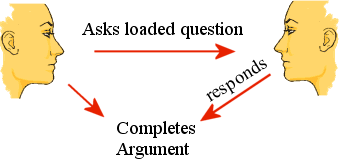|
This fallacy occurs when a single question that is really two (or more) questions is asked, and a single answer is illegitimately applied to both.
Examples:
- Have you stopped beating your wife?
- If you answer, "yes," then you are trapped into the implication that you have beaten your wife in the past;
- If you answer "no," then you are trapped into the implication that you are still beating your wife!
- This is really a disguised form of two separate questions: 1) Have you beaten your wife in the past? and, 2) if so, have you stopped now?
- Resolution: Expose the trap as really two questions posed to look as one.
- You should support home education and the God-given right of parents to raise their children according to their own beliefs.
- You are asked to agree to both propositions, when you could choose one, either but not both, or perhaps both.
- Do you support freedom and the right to bear arms?
- Are you going to be a good little boy and eat your hamburger?
- Have you stopped using illegal sales practices?
Note: A "leading question" is one that begs the question of its truth. It is common in law courts. For example:
- Tell the court, Mr. Jones, whether on April 9th at approximately 7:25 pm you did see the defendant shoot the deceased?
This is a leading question since the answer will be used to corroborate the idea that the defendant did indeed shoot the deceased, whereas a more straighforward (and honest) question would be, "Tell the court, Mr. Jones, what did you see on April 9th at 7:25 pm? - This example from Hurley (156).
Proof: Identify the two propositions illegitimately conjoined and show that they are not necessarily logically connected.
References:
Cedarblom and Paulsen: 86, Copi and Cohen: 96
<< Return
|

